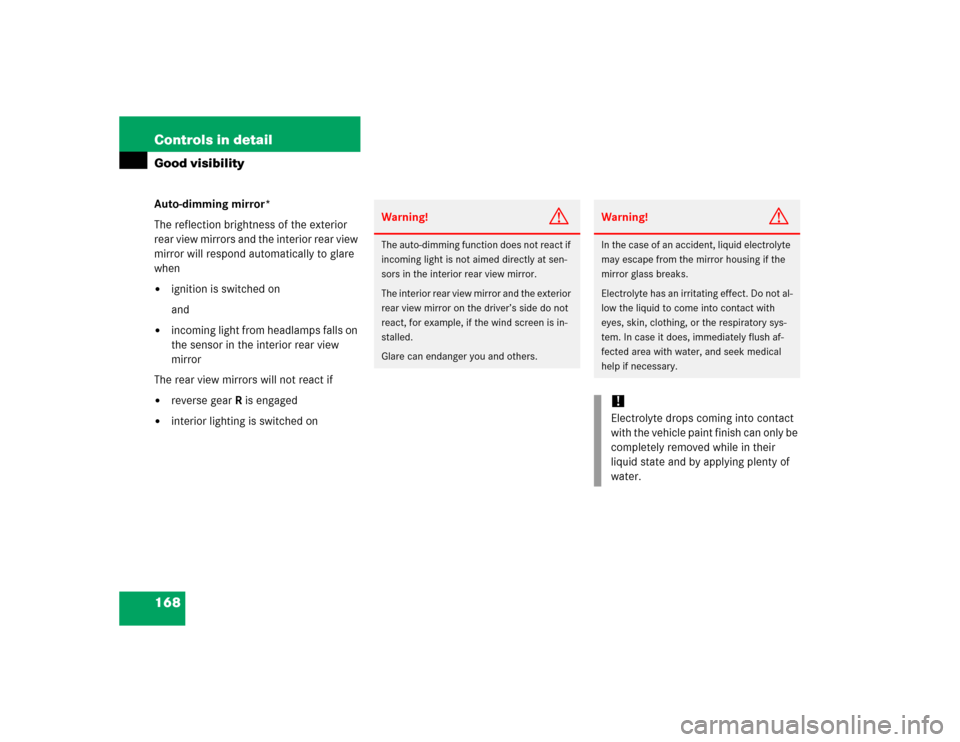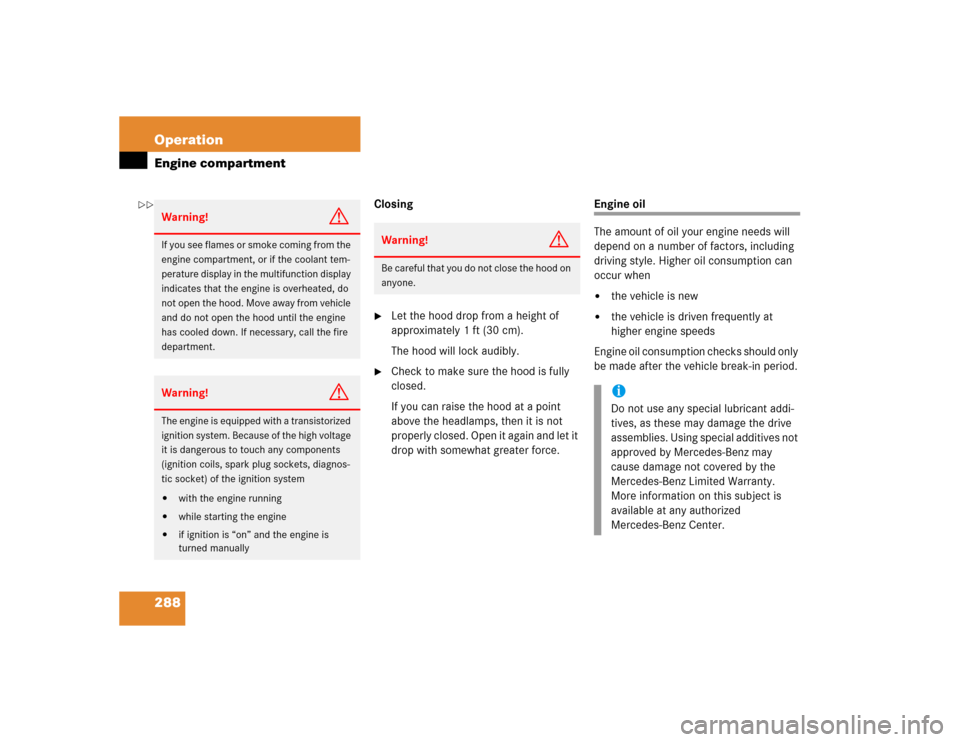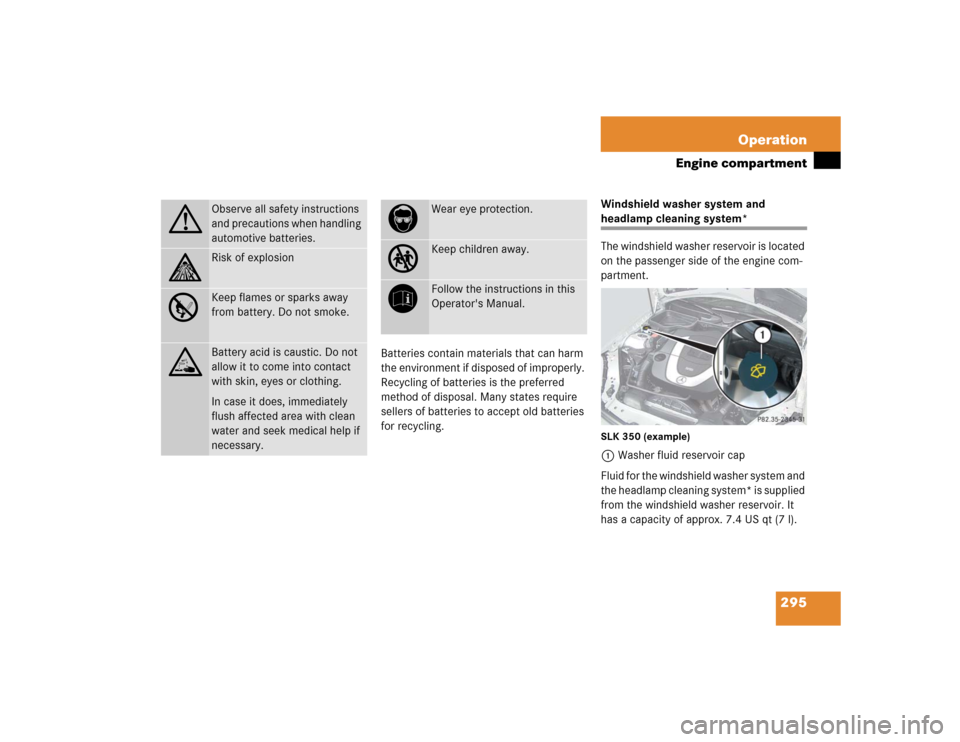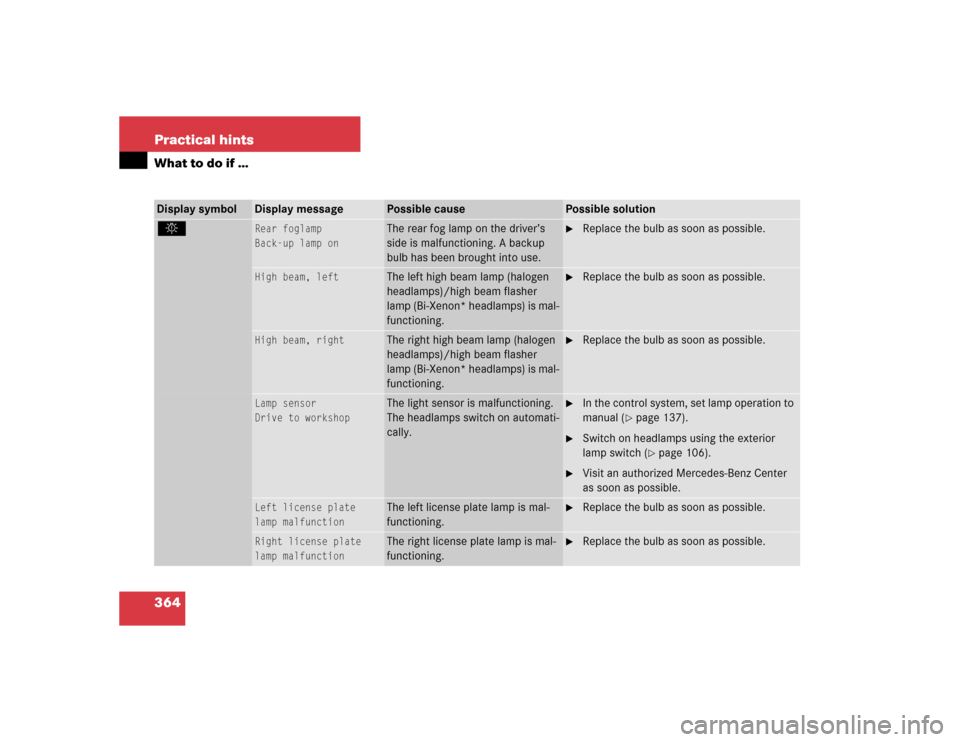Page 168 of 464

168 Controls in detailGood visibilityAuto-dimming mirror*
The reflection brightness of the exterior
rear view mirrors and the interior rear view
mirror will respond automatically to glare
when�
ignition is switched on
and
�
incoming light from headlamps falls on
the sensor in the interior rear view
mirror
The rear view mirrors will not react if
�
reverse gearR is engaged
�
interior lighting is switched on
Warning!
G
The auto-dimming function does not react if
incoming light is not aimed directly at sen-
sors in the interior rear view mirror.
The interior rear view mirror and the exterior
rear view mirror on the driver’s side do not
react, for example, if the wind screen is in-
stalled.
Glare can endanger you and others.
Warning!
G
In the case of an accident, liquid electrolyte
may escape from the mirror housing if the
mirror glass breaks.
Electrolyte has an irritating effect. Do not al-
low the liquid to come into contact with
eyes, skin, clothing, or the respiratory sys-
tem. In case it does, immediately flush af-
fected area with water, and seek medical
help if necessary.!Electrolyte drops coming into contact
with the vehicle paint finish can only be
completely removed while in their
liquid state and by applying plenty of
water.
Page 288 of 464

288 OperationEngine compartment
Closing�
Let the hood drop from a height of
approximately 1 ft (30 cm).
The hood will lock audibly.
�
Check to make sure the hood is fully
closed.
If you can raise the hood at a point
above the headlamps, then it is not
properly closed. Open it again and let it
drop with somewhat greater force.
Engine oil
The amount of oil your engine needs will
depend on a number of factors, including
driving style. Higher oil consumption can
occur when�
the vehicle is new
�
the vehicle is driven frequently at
higher engine speeds
Engine oil consumption checks should only
be made after the vehicle break-in period.
Warning!
G
If you see flames or smoke coming from the
engine compartment, or if the coolant tem-
perature display in the multifunction display
indicates that the engine is overheated, do
not open the hood. Move away from vehicle
and do not open the hood until the engine
has cooled down. If necessary, call the fire
department.Warning!
G
The engine is equipped with a transistorized
ignition system. Because of the high voltage
it is dangerous to touch any components
(ignition coils, spark plug sockets, diagnos-
tic socket) of the ignition system�
with the engine running
�
while starting the engine
�
if ignition is “on” and the engine is
turned manually
Warning!
G
Be careful that you do not close the hood on
anyone.
iDo not use any special lubricant addi-
tives, as these may damage the drive
assemblies. Using special additives not
approved by Mercedes-Benz may
cause damage not covered by the
Mercedes-Benz Limited Warranty.
More information on this subject is
available at any authorized
Mercedes-Benz Center.
��
Page 295 of 464

295 Operation
Engine compartment
Batteries contain materials that can harm
the environment if disposed of improperly.
Recycling of batteries is the preferred
method of disposal. Many states require
sellers of batteries to accept old batteries
for recycling.Windshield washer system and
headlamp cleaning system*
The windshield washer reservoir is located
on the passenger side of the engine com-
partment.SLK 350 (example)1Washer fluid reservoir cap
Fluid for the windshield washer system and
the headlamp cleaning system* is supplied
from the windshield washer reservoir. It
has a capacity of approx. 7.4 US qt (7 l).
G
Observe all safety instructions
and precautions when handling
automotive batteries.
A
Risk of explosion
D
Keep flames or sparks away
from battery. Do not smoke.
B
Battery acid is caustic. Do not
allow it to come into contact
with skin, eyes or clothing.
In case it does, immediately
flush affected area with clean
water and seek medical help if
necessary.
E
Wear eye protection.
C
Keep children away.
F
Follow the instructions in this
Operator's Manual.
Page 296 of 464

296 OperationEngine compartmentDuring all seasons, add MB Windshield
Washer Concentrate “S” to water. Premix
the windshield washer fluid in a suitable
container.�
Pull cap upward using latch until it
opens.
�
Refill the reservoir with MB Windshield
Washer Concentrate and water (or
commercially available premixed wind-
shield washer solvent/antifreeze, de-
pending on ambient temperatures).
Always use washer solvent/antifreeze
where temperatures may fall below
freezing point. Failure to do so could re-
sult in damage to the washer sys-
tem/reservoir.
�
Push cap down until it engages.For more information, see “Windshield
washer system and headlamp cleaning
system*” (
�page 429).
Warning!
G
Washer solvent/antifreeze is highly flamma-
ble. Do not spill washer solvent/antifreeze
on hot engine parts, because it may ignite
and burn. You could be seriously burned.!Only use washer fluid which is suitable
for plastic lenses. Improper washer flu-
id can damage the plastic lenses of the
headlamps.
Page 327 of 464

327 Operation
Winter driving
�Winter driving
Before the onset of winter, have your
vehicle winterized at an authorized
Mercedes-Benz Center. This service
includes:�
Checking anticorrosion and antifreeze
concentration.
�
Adding of cleaning concentrate to the
water of the windshield and headlamp
cleaning* system. Add
MB Concentrate “S” to a pre-mixed
windshield washer solvent/antifreeze
which is formulated for temperatures
below freezing point (
�page 429).
�
Battery test. Battery capacity drops
with decreasing ambient temperature.
A well charged battery helps to make
sure the engine can be started, even at
low ambient temperatures.
�
Tire change. Mercedes-Benz recom-
mends M+S rated radial-ply tires with a
minimum tread depth of approximately 1/6in (4.0 mm) on all four wheels for
the winter season.
Winter tires
Always use winter tires at temperatures
below 45°F (7°C) and whenever wintry
road conditions prevail. Using winter tires
is the only way to achieve the maximum ef-
fectiveness of the ABS and ESP in winter
operation.
For safe handling, make sure all mounted
winter tires are of the same make and have
the same tread design.Always observe the speed rating of the
winter tires mounted to your vehicle. If the
maximum speed for which your tires are
rated is below the speed rating of your ve-
hicle, you must place a notice to this effect
where it will be seen by the driver. Such no-
tices are available at your tire dealer or any
authorized Mercedes-Benz Center.
!When scraping ice or snow from the
rear window, be careful not to damage
the sealing strip or apertures along the
side of the window.
Warning!
G
Winter tires with a tread depth under
1/6 in
(4 mm) must be replaced. They are no long-
er suitable for winter operation.
Page 337 of 464

337 Operation
Vehicle care
To prevent damage to the antenna, un-
screw and remove antenna on left rear
side of vehicle before taking the vehicle
through a car wash. Note that without the
antenna on the left rear side of the vehicle
installed, the signaling range of the
SmartKey is considerably reduced. Hold
the SmartKey in close proximity towards
the antenna base when locking and un-
locking the vehicle.
In the winter, thoroughly remove all traces
of road salt as soon as possible.
When washing the undercarriage, do not
forget to clean the inner sides of the
wheels.Ornamental moldings
For regular cleaning and care of very dirty
chrome-plated parts, use a chrome clean-
er.
Headlamps, side makers, tail lamps,
turn signal lenses
Use a mild car wash detergent, such as
Mercedes-Benz approved Car Shampoo,
with plenty of water.
To prevent scratches, never apply strong
force and use only a soft, non-scratchy
cloth when cleaning the lenses. Do not at-
tempt to wipe dirty lenses with a dry cloth
or sponge.Wiper blades
�
Switch on wipers and place them in a
vertical position.
For information on placing the wipers
in a vertical position, see “Replacing
wiper blades” (
�page 386).
!The windshield wipers must be in a ver-
tical position before folding them away
from the windshield. They could other-
wise damage the hood.
��
Page 349 of 464
349 Practical hints
What to do if …
On the pages that follow, you will find a
compilation of the most important warning
and malfunction messages that may ap-
pear in the multifunction display.
For your convenience the messages are
divided into two sections:�
Text messages (
�page 350)
�
Symbol messages (
�page 355)
Warning!
G
No messages will be displayed if either the
instrument cluster or the multifunction dis-
play is inoperative.
Contact your nearest authorized
Mercedes-Benz Center.
iSwitching on ignition (
�page 35)
causes all instrument cluster lamps
(except high beam headlamp indicator
lamp and turn signal indicator lamps
unless activated) as well as the multi-
function display to come on. Make sure
the lamps and multifunction display are
in working order before starting your
journey.
Page 364 of 464

364 Practical hintsWhat to do if ….
Rear foglamp
Back-up lamp on
The rear fog lamp on the driver’s
side is malfunctioning. A backup
bulb has been brought into use.
�
Replace the bulb as soon as possible.
High beam, left
The left high beam lamp (halogen
headlamps)/high beam flasher
lamp (Bi-Xenon* headlamps) is mal-
functioning.
�
Replace the bulb as soon as possible.
High beam, right
The right high beam lamp (halogen
headlamps)/high beam flasher
lamp (Bi-Xenon* headlamps) is mal-
functioning.
�
Replace the bulb as soon as possible.
Lamp sensor
Drive to workshop
The light sensor is malfunctioning.
The headlamps switch on automati-
cally.
�
In the control system, set lamp operation to
manual (
�page 137).
�
Switch on headlamps using the exterior
lamp switch (
�page 106).
�
Visit an authorized Mercedes-Benz Center
as soon as possible.
Left license plate
lamp malfunction
The left license plate lamp is mal-
functioning.
�
Replace the bulb as soon as possible.
Right license plate
lamp malfunction
The right license plate lamp is mal-
functioning.
�
Replace the bulb as soon as possible.
Display symbol
Display message
Possible cause
Possible solution